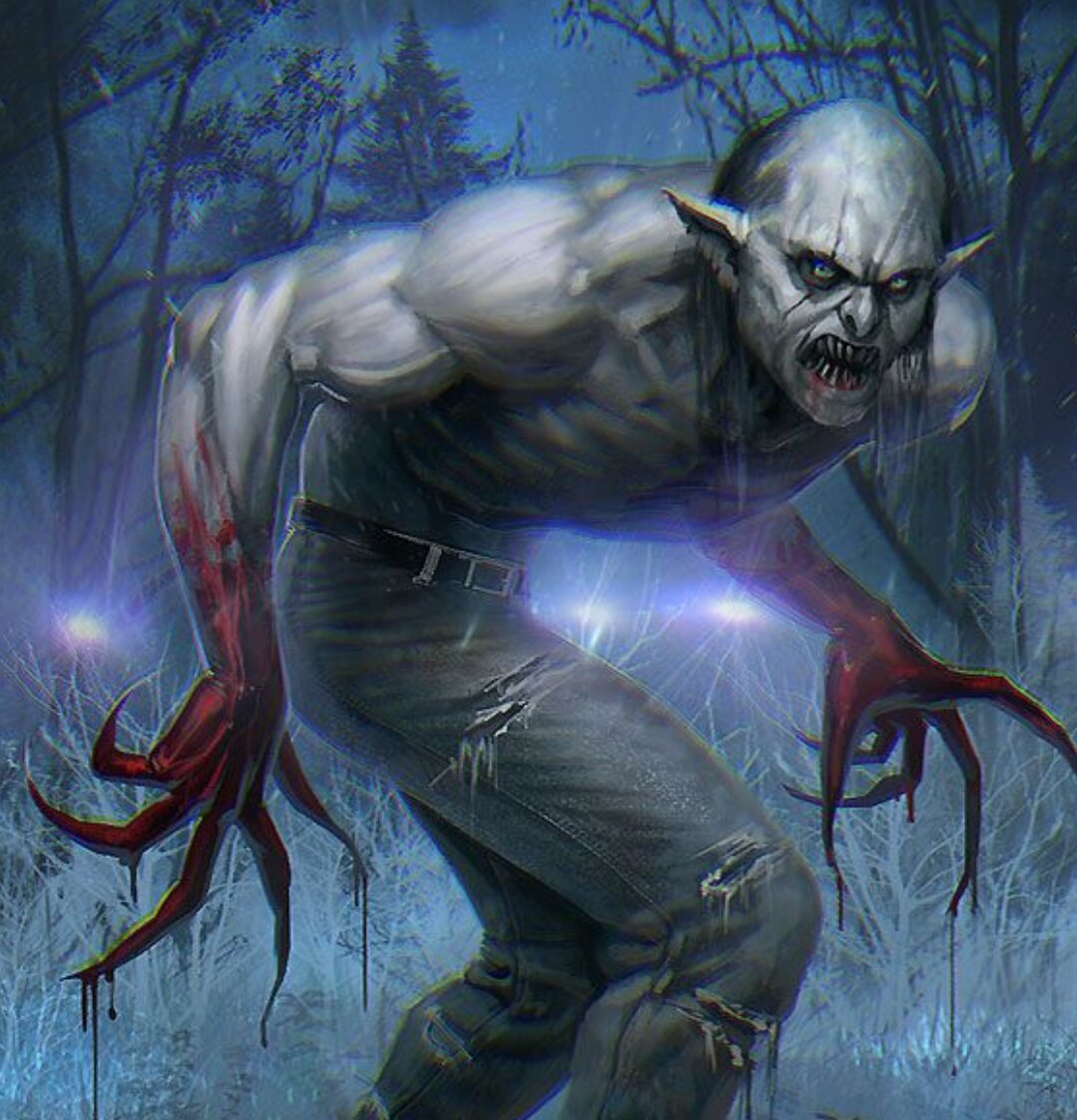Анализ литературного образа вурдала́ка.
Цикл: лингвистические характеристики характеров и ситуаций

Автор: Ершов Денис Иванович
Вурадалак - это живой мертвец, обычно возрождающийся из мёртвых людей или из тех, которые были укушены другим вурдалаком . Ein Ghul (arabisch غُول, DMG ġūl [ɣuːl]) ist üblicherweise ein leichenfressendes Fabelwesen und erscheint in verschiedenen mythologischen und literarischen Formen. La goule (de l'arabe الغول, al-ghoûl ; féminin al-ghoûla ; « l'ogre ») est une créature monstrueuse du folklore arabe préislamique qui apparaît dans les contes des Mille et Une Nuits. A ghoul (from Arabic: غول, ghūl) is a demon-like being or monstrous humanoid, often associated with graveyards and the consumption of human flesh. Встречаются в поверьях и легендах западных и центральных славян. Пьют кровь родных; обычно из-за появления вурдалаков вымирают целые деревни, так как они умерщвляют в первую очередь, обращая их тоже вурдалаками, самых близких людей. The concept originated in pre-Islamic Arabian religion. Modern fiction often uses the term to label a specific kind of monster. Ce personnage a été repris dans la mythologie occidentale, avec une attraction probable du latin « gula », signifiant « gueule » et ses dérivés « goulu », « goulûment ».
Il est popularisé dans la littérature fantastique. Dans les œuvres d'Edgar Allan Poe, la goule se transforme en femme afin d'attirer ses victimes. Elle n'est cependant ni homme, ni femme, ni bête, ni humaine. Le romancier populaire du XIXe siècle Paul Féval fait de la goule la femelle du vampire. Dans son livre La Vampire (1856), un vampire femelle hante le Paris de 1804, où elle est mêlée au complot de Georges Cadoudal contre le Premier Consul. Dans un épisode comique, le secrétaire général de la préfecture de la Seine étale sa science en précisant que la femelle du vampire n'est pas appelée une vampire, mais une « oupire » ou une « goule ». Toujours en France, cette créature apparait en 1905 dans Les Goules, un drame en deux actes de Jean Lorrain et Charles Esquier.
L'auteur de récits fantastiques H. P. Lovecraft en fait des nécrophages qu'on rencontre également dans les « contrées du Rêve ». Le jeu de rôles tiré de ses œuvres, L'Appel de Cthulhu, les montre comme capables d'absorber les souvenirs de leur « repas » et de prendre son aspect pour un temps limité. De surcroît, trop fréquenter les goules peut mener un humain à devenir goule lui-même. Un ouvrage fictif du mythe de Cthulhu tourne même autour des goules : le Culte des Goules, prétendument écrit en 1702 par le comte d'Erlette.
Les goules deviennent des morts-vivants dans The Dead Don't Die de Jim Jarmush. Le terme est ainsi parfois utilisé pour désigner les zombies. Dans l'univers du Monde des Ténèbres, le mot caractérise les serviteurs des vampires6.
Les Goules apparaissent dans la série de jeux vidéos Dragon Quest, partageant leur sprite avec ceux des Mort-Vivants, à quelques couleurs près.
L'univers des jeux-vidéos Fallout exploite également le terme de goule pour désigner les individus ayant subis de graves mutations dues aux radiations.
By extension, the word ghoul is also used in a derogatory sense to refer to a person who delights in the macabre or whose occupation directly involves death, such as a gravedigger or graverobber.
Elle forme une classe de djinns, comme les éfrits par exemple. Les goules changent de forme, prenant le plus souvent l'apparence d'une hyène ou celle d'une femme, mais elles sont reconnaissables à leurs pieds fourchus, seul élément constant de leur apparence.
Le mot « goule » vient de l'arabe « ghul », dérivé de « ghala » qui signifie « saisir »3. On retrouve ses homologues dans la mythologie hindoue (yogni et dakini), chaldéenne (utug et gigim, démons du désert) et slave (Baba Yaga. Le poète préislamique Ta'abbata Charrane décrit dans l'un de ses poèmes sa rencontre et sa lutte contre une goule.
La goule affectionne les cimetières, où elle déterre les cadavres pour s'en nourrir. La goule hante aussi le désert sous les traits d'une jeune femme et elle dévore les voyageurs qui succombent à ses appels, non sans rappeler les sirènes du récit de l’Odyssée. Dans les pays d'Afrique du Nord, de nombreux récits terrifiants destinés aux enfants ont pour personnage principal une goule, qui y joue souvent un rôle équivalent à celui du grand méchant loup.
Вурдала́к:
Вурдалак — мифическое существо, живой мертвец-вампир.
Вурдалак — имя главаря трёхсот великанов из романа Франсуа Рабле «Гаргантюа и Пантагрюэль» (в русском переводе).
«Вурдалак» — стихотворение Александра Пушкина из цикла «Песни западных славян» (1834).
«Вурдалак» — вторая часть фильма Марио Бавы «Три лика страха» (1963), поставленная по повести Алексея Толстого «Семья вурдалака».
«Гоблины», или «Вурдалаки» (англ. Ghoulies) — комедийный фильм ужасов Луки Берковича (США, 1985).
«Вурдалаки» — мистический триллер Сергея Гинзбурга по повести Алексея Толстого (Россия, 2017). Persisch-arabischer Kulturkreis
Der Ghul ist im persisch-arabischen Kulturkreis ein gefährlicher Dämon und gehört zu den Dschinnen. Das weibliche Gegenstück zum Ghul wird Ghula genannt. Der Ghul kann in verschiedene Gestalten schlüpfen und Reisende in der Wüste oder im Wald vom Weg ablocken, um sie zu verschlingen. Nur seine Füße bleiben stets Eselshufe, wodurch der Ghul erkannt werden kann. Als Dschinn kann der Ghul sich zum Islam bekennen und lässt dadurch seine wilde und gefährliche Natur hinter sich und könnte den Menschen freundlich gesinnt sein. In zahlreichen Mythen und Märchen, vor allem in den Erzählungen aus Tausendundeiner Nacht, spielen Ghule eine Rolle.
Europa
In der klassischen europäischen Literatur und Mythologie ist der menschen- und leichenfressende Ghul im eigentlichen Sinn nicht anzutreffen. Erst nach der Veröffentlichung der Erzählungen aus Tausendundeine Nacht in Europa wurde der Ghul dort zum Begriff. Eine romantische Variante des Motivs findet sich in E.T.A. Hoffmanns Erzählung Vampirismus aus seinem Erzählzyklus Die Serapionsbrüder. Im 20. Jahrhundert erlangte der Ghul mehr Bekanntheit, besonders durch die Schauerliteratur des amerikanischen Schriftstellers H. P. Lovecraft, der stark durch diese Sammlung von Erzählungen beeinflusst wurde. In Lovecrafts Werken haben Ghule hundeähnliche Gesichtszüge und leben unterirdisch in der Nähe von Friedhöfen gemeinschaftlich zusammen.
Если человека заразили, то он не сразу становится кровопийцей. Процесс трансформации длиться от нескольких часов до нескольких дней, всё зависит от воли. Укусивший вурдалак должен сначала подчинить себе сознание и волю заражённого, и только потом уже начинаются физические трансформации.
Сначала меняется цвет глаз, зрачки становятся красными, как кровь. Начинается агония, сильная реакция на дневной свет (ультрафиолет). Вырастают клыки. Окончательный процесс трансформации завершается, после того, как новорождённый упырь выпьет первый глоток крови.
Русский
| 
| В Викиданных есть лексема вурдалак (L98080). |
Морфологические и синтаксические свойства
| падеж | ед. ч. | мн. ч. |
| Им. | вурдала́к | вурдала́ки |
| Р. | вурдала́ка | вурдала́ков |
| Д. | вурдала́ку | вурдала́кам |
| В. | вурдала́ка | вурдала́ков |
| Тв. | вурдала́ком | вурдала́ками |
| Пр. | вурдала́ке | вурдала́ках |
вур-да-ла́к
Существительное, одушевлённое, мужской род, 2-е склонение (тип склонения 3a по классификации А. А. Зализняка). Вурдалаки — жители ночи. Умею очень хорошо скрываться под ночным покровом. Но, обычно выдают их глаза, которые имеют некий блеск. Кровосос очень силён, а поэтому сопротивляться такому существу достаточно сложно. На слабых волею и разумом может повлиять гипноз, который используют в охоте древние вурдалаки. Эти хитрые умруны охотятся на путешественников в кладбищах и густых лесах, которые являются их излюбленными местами. Они прячутся в логовах и ждут, когда мимо пройдут люди. Они очень любят человеческую плоть. Они часто заманивают в ловушку своих жертв, когда темно. Они любят вкус человеческой плоти, и не важно, насколько она свежа (или мертва). Они часто разоряют могилы в поисках пищи.
Etymology
Ghoul is from the Arabic غُول (ghūl), from غَالَ (ghāla) 'to seize'. In Arabic, the term is also sometimes used to describe a greedy or gluttonous individual.
The term was first used in English literature in 1786 in William Beckford's Orientalist novel Vathek, which describes the ghūl of Arabic folklore. This definition of the ghoul has persisted until modern times with ghouls appearing in popular culture.
Folklore
 Ghouls gathering for combat in a Persian poem.
Ghouls gathering for combat in a Persian poem.
In Arabic folklore, the ghul is said to dwell in cemeteries and other uninhabited places. A male ghoul is referred to as ghul while the female is called ghulah. A source identified the Arabic ghoul as a female creature who is sometimes called Mother Ghoul (ʾUmm Ghulah) or a relational term such as Aunt Ghoul. She is portrayed in many tales luring hapless characters, who are usually men, into her home where she can eat them.
Some state that a ghoul is a desert-dwelling, shapeshifting demon that can assume the guise of an animal, especially a hyena. It lures unwary people into the desert wastes or abandoned places to slay and devour them. The creature also preys on young children, drinks blood, steals coins, and eats the dead, then taking the form of the person most recently eaten. One of the narratives identified a ghoul named Ghul-e Biyaban, a particularly monstrous character believed to be inhabiting the wilderness of Afghanistan and Iran. Moderne Darstellungen
Literatur
Ghule treten häufig als leichenfressende Dämonen in Horror- oder Grusel-Heftromanen auf, wo sie meist als schleimig und Verwesungsgeruch absondernd beschrieben werden. So beinhalten Serien wie Geisterjäger John Sinclair oder Professor Zamorra in vielen Romanen den Kampf gegen Ghule. Das ursprüngliche Motiv kann dabei stark verändert sein, teilweise wird das Wort ohne Bezug zur Historie für nicht menschliche Wesen verwendet.
Ghule spielen auch in der Bücherreihe von Dennis L. McKiernan eine große Rolle. Dort werden sie als leichenblasse Wesen von Menschengröße, mit hohlen Augen und rissigen Lippen beschrieben.
In Terry Pratchetts Scheibenwelt-Romanen werden Ghule (teilweise auch „Gule“) als beinahe ausgestorben bezeichnet. Wie viele andere mythologische Gestalten auch sind sie zwar weitgehend in die Gesellschaft integriert, allerdings nicht sehr beliebt.
Wolfgang Hohlbein greift das Motiv der Ghule u. a. in seinen Romanen Anubis und Unterland auf.
In Joanne K. Rowlings Harry-Potter-Romanen kommt ein Ghul vor, der in der Dachkammer der Familie Weasley haust. Im 7. Band macht sich Ronald Weasley den Ghul zu Nutze, der Rons alten Schlafanzug anzieht und sich als „Ronald mit schwerer Erkrankung“ ausgibt („Grieselkrätze“, schwer ansteckend), während Ron selbst tatsächlich zusammen mit Harry Potter und Hermine Granger auf der Flucht ist.
Auch im Manga und Anime Tokyo Ghoul werden die menschenfressenden Monster behandelt. Dort sind sie eine eigene Gesellschaft und tarnen sich normalerweise als Menschen. Sie ermorden die Menschen teils zum Spaß, teils um zu überleben. Außerdem besitzen die Ghule dort übermenschliche Fähigkeiten sowie einen Geschmackssinn, der die meisten Lebensmittel verdorben schmecken lässt. Sie können sich nur von Menschenfleisch und Ghulfleisch ernähren.
Ghule kommen auch in der Bücherreihe von Jeaniene Frost (The Night Huntress Serie) vor. Dort sind sie durch die Art, wie sie erschaffen werden, artverwandt mit den Vampiren.
Im vierten Band von T. A. Barrons Merlin-Saga werden Ghule als unheimliche Moorgeister beschrieben, die dort ihr Unwesen treiben und Unheil stiften. Als der junge Zauberer Merlin ihnen jedoch hilft, revanchieren sie sich bei ihm, indem sie ihm ebenfalls helfen.
Karl Edward Wagner erwähnt Ghule in seinem Roman Herrin der Schatten.
Frank Rehfeld beschreibt in seinem Roman Zwergenbann Ghule als Mischwesen zwischen Mensch, Tier und möglicherweise Dämon, die bleichen, dürren Menschen mit einzelnen Haarsträhnen und einem extrem großen, mit messerähnlichen Zähnen gefüllten Mund ähneln und sich in erster Linie von Leichen ernähren, die sie restlos vertilgen, aber auch lebende Menschen anfallen, wenn ihnen dies als sicher erscheint. Sie sind sonnenlichtscheu, wagen sich aber dennoch für wenige Sekunden hinein, um Beute zu machen. Sie leben in unterirdischen Bauen und die Menschen glauben, dass Ghule nicht nur den Körper, sondern auch die Seelen ihrer Opfer verschlingen.
In Ghoul Trouble von John Passarella bekämpft Buffy vier Ghul-Mädchen, die Männer ihrem Bann unterwerfen.
Im Buch Leichenfresser (Ghoul) des US-amerikanischen Schriftstellers Brian Keene spielt ein Ghul eine zentrale Rolle.
Videospiele
In Computerspielen wird Ghul gelegentlich als Bezeichnung genutzt, die auch hier häufig vom historischen Kontext losgelöst ist.
Im Echtzeit-Strategiespiel Warcraft 3 heißt eine untote Kampf- und Arbeitseinheit Ghul, die durch den Verzehr von Leichen schnell Lebenspunkte regeneriert. Sie kommt ebenfalls im Online-Rollenspiel World of Warcraft, sowie im Online-Sammelkartenspiel Hearthstone vor.
In der Fallout-Reihe, die nach einem nuklearen Weltkrieg angesiedelt ist, tauchen Ghule als entweder normale, durch radioaktive Strahlung mutierte Menschen oder als menschenfressende Bestien auf.
Im Spiel Dark Messiah of Might and Magic kommen Ghule als Gefangene zwischen Leben und Tod sowie als Ausgeschlossene aus dem Kreis der Wiedergeburt vor, es sind Menschen, welche in Ghule verwandelt wurden.
In den Spielen Risen und Risen 2 Dark Waters sind Ghule schwarze, koboldähnliche Wesen, welche die Leiche des Spielers nach dessen Tod verzehren.
Rollenspiele
In Fantasy-Rollenspielen tauchen Ghule ebenfalls häufig als zu überwindende Gegner auf und haben meist die Gemeinsamkeit, sich von Leichen zu ernähren. Die besonderen Eigenschaften können aber auch hier stark variieren.
So sind Ghule im Pen-&-Paper-Rollenspiel Vampire: The Masquerade normale Menschen, die einmal im Monat das Blut ihrer Vampirmeister zu trinken bekommen. Dieser Konsum macht sie stärker, heilt Wunden und stoppt jede Alterung, führt aber auch zur Sucht. Bricht die Nachfuhr von Vampirblut ab, so wird die natürliche Alterung nachgeholt, was bei jahrhundertealten Ghulen bedeutet, dass sie zu Staub zerfallen.
Ähnliche Ghul-Arten lassen sich auch in anderen Rollenspielen finden, wie zum Beispiel im Rollenspiel The Witcher. Dort treten sie ebenfalls als Leichen fressende Monster auf, und es gibt einige Unterarten.
Spielfilm und Serie
Im Film wird der Begriff Ghul oft für wiederbelebte Tote – Untote – verwendet, darunter vor allem Zombies und Vampire. Im britischen Film The Ghoul von 1933 wird der von Boris Karloff dargestellte Wiedergänger als titelgebender Ghul bezeichnet. Dies ist die erste Verwendung des Begriffs in einem Langfilm.
Der Film-Regisseur Ed Wood drehte mehrere Filme um das Fabelwesen, darunter Plan 9 aus dem Weltall und Night of the Ghouls. Einen gewissen Kultstatus erlangte die Spielfilm-Tetralogie Ghoulies I–IV (USA 1983–1994).
Im Film Die Nacht der lebenden Toten von 1968 ist in der englischen Originalversion von Ghulen die Rede, nie von Zombies. George A. Romero hatte eine Darstellung von Zombies nicht beabsichtigt.[2]
In der 2018 veröffentlichten Netflix-Miniserie Ghul erscheint das titelgebende Monster als mörderischer Gestaltwandler, der mit menschlichem Blut beschworen werden kann.
Bei Supernatural (Staffel 4/Folge 19) kommen Ghule als Leichenfresser vor. In der Serie können sie die Gestalt ihrer Opfer annehmen und pflegen untereinander familiäre Beziehungen.
Musik
Morbid Angel widmen sich 1989 dem Thema mit den Lied Chapel of Ghouls auf ihrem Debütalbum Altars of Madness.
Im Song Ghuleh / Zombie Queen der Band Ghost spielt ein weiblicher Ghul, welcher sich im Mondlicht in eine anmutige Gestalt verwandelt, die Hauptrolle.
In Alice Coopers 2011 erschienenen Album Welcome 2 My Nightmare erzählt das Lied Ghoules Gone Wild von wildgewordenen Ghoulen.
Die maskierten und anonymen Mitglieder der Band Ghost werden jeweils mit „A Nameless Ghoul“ (engl. ‚Ein namenloser Ghul‘) angegeben.
Die niederländische Symphonic-Black-Metal-Band Carach Angren behandelt das Thema auf ihrem 2020 erschienenen Album Franckensteina Strataemontanus im Lied Scourged Ghoul Undead.
Al-Dimashqi describes the ghoul as cave-dwelling animals who only leave at night and avoid the light of the sun. They would eat both humans as well as animals.
It was not until Antoine Galland translated One Thousand and One Nights into French that the Western concept of ghouls was introduced into European society. Galland depicted the ghoul as a monstrous creature that dwelled in cemeteries, feasting upon corpses.
Islam
Ghouls are not mentioned in the Quran, but in hadith. Exegetes of the Quran (tafsir) conjectured that the ghouls might be burned jinn or devils. Accordingly, the jinn and shayatin (devils) once had access to the heavens, where they eavesdropped, and returned to Earth to pass hidden knowledge to the soothsayers. When Jesus was born, three heavenly spheres were forbidden to them. With the arrival of Muhammad, the other four were forbidden. The marid among the shayatin continued to rise to the heavens, but were burned by comets. If these comets didn't burn them to death, they were deformed and driven to insanity. They then fell to the deserts and were doomed to roam the earth as ghouls.
In one[which?] hadith it is said, lonely travelers can escape a ghoul's attack by repeating the adhan (call to prayer). When reciting the Throne Verse, a ghoul, in contrast to a devil, might decide to convert to Islam.
The ghoul could appear in male and female shape, but usually appeared female to lure on male travelers to devour them. Al-Masudi reports that on his journey to Syria, Umar slew a ghoul with his sword. According to History of the Prophets and Kings, the rebellious (maradatuhum) among the devils and the ghouls have been chased away to the deserts and mountains and valleys a long time ago.
A ghoul is said to have stolen dates from the house of Abu Ayyub al-Ansari. When she got captured, she promised to teach Ayat Al-Kursi, as a prayer to protect the house from devils and other misfortune, if he releases her. Muhammad told him that the ghoul spoke the truth, although she is a liar.
Other Muslim scholars, like Abī al-Sheikh al-Aşbahânī, describe the ghoul as a kind of female jinn that was able to change its shape and appear to travelers in the wilderness to delude and harm.
In ancient Mesopotamia, there was a folklore monster called 'Gallu' that could be[weasel words] regarded as one of the origins of the Arabic ghoul. Gallu was an Akkadian demon of the underworld responsible for the abduction of vegetation god Dumuzid to the realm of death.
The word ghoul entered the English tradition and was further identified as a grave-robbing creature that feeds on dead bodies and children. In the West, ghouls have no specific shape and have been described by Edgar Allan Poe as "neither man nor woman... neither brute nor human."
In "Pickman's Model", a short story by H. P. Lovecraft, ghouls are members of a subterranean race. Their diet of dead human flesh mutated them into bestial humanoids able to carry on intelligent conversations with the living. The story has ghouls set underground with ghoul tunnels that connect ancient human ruins with deep underworlds. Lovecraft hints that the ghouls emerge in subway tunnels to feed on train wreck victims.
Légende
L'étoile du démon
Algol est une étoile. L'origine de son nom est la même que celui du mot « goule ». Les astronomes arabes ont vu que sa luminosité changeait : elle diminuait, puis s'intensifiait de nouveau au bout de quelques jours. Étonnés, les savants en ont déduit que, au centre de l'astre, se trouvait un démon. En 1783, un jeune astronome, John Goodricke, découvrit que ces changements de lumière étaient en fait le signe de la présence de 2 étoiles : l'une, plus petite, passe tous les 4 jours devant la seconde, bloquant ses rayons. Quand la petite étoile part, la plus grosse redevient entièrement visible.
Lovecraft's vision of the ghoul, shared by associated authors Clark Ashton-Smith and Robert E. Howard, has heavily influenced the collective idea of the ghoul in American culture. Ghouls as described by Lovecraft are dog-faced and hideous creatures but not necessarily malicious. Though their primary (perhaps only) food source is human flesh, they do not seek out or hunt living people. They are able to travel back and forth through the wall of sleep. This is demonstrated in Lovecraft's "The Dream Quest of Unknown Kadath" in which Randolph Carter encounters Pickman in the dream world after his complete transition into a mature ghoul.
Ghouls in this vein, are also changelings in the traditional way. The ghoul parent abducts a human infant and replaces it with one of its own. Ghouls appear entirely human as children but begin to take on the "ghoulish" appearance as they age past adulthood. The fate of the replaced human children is not entirely clear but Pickman offers a clue in the form of a painting depicting mature ghouls as they encourage a human child while it cannibalizes a corpse. This version of the ghoul appears in stories by authors such as Neil Gaiman, Brian Lumley, and Guillermo del Toro.
In the Fallout series, ghouls are humans who have been exposed to large amounts of radiation, which causes their skin and voice to become damaged and makes them functionally immortal. Some ghouls completely lose the ability to function as they did when human, which are known as feral ghouls. In turn, some feral ghouls begin glowing from their radiation, and these are known as Glowing Ones.
Корень: -вурдалак- [Тихонов, 1996].
Произношение
МФА: ед. ч. [vʊrdɐˈɫak], мн. ч. [vʊrdɐˈɫakʲɪ]
Семантические свойства
Значение
мифол. по народным поверьям — мертвец, оборотень, выходящий ночью из могилы, чтобы сосать кровь живых людей; вампир ◆ Ваня стал; — шагнуть не может. // Боже! думает бедняк, // Это, верно, кости гложет // Красногубый вурдалак. А. С. Пушкин, «Вурдалак», 1835 г. ◆ Ежели будет так, приказываю вам — забудьте, что я вам был отец, и вбейте мне осиновый кол в спину, что бы я ни говорил, что бы ни делал, — значит, я теперь проклятый вурдалак и пришёл сосать вашу кровь. А. К. Толстой, «Семья вурдалака», 1839 г.
перен. жестокий человек ◆ Отсутствует пример употребления (см. рекомендации).
Вурдалаки часто изображаются в виде людей, которые восстали из мёртвых. Вурдалаки не очень умны. Возможно, они собирались в одну группу, чтобы нападать на людей, и предпочитали старых и слабых жертв. Они ходили по кладбищу, открывая гробы, чтобы съесть человеческие трупы. Гроб с отсутствующими гвоздями - верный признак того, что тут был вурдалак.
Craig n'était pas une goule, et si son père n'en avait pas eu après Grissom, le considèreriez-vous d'une autre manière ?
Крэйг не выглядел как вурдалак, и если бы его отец не преследовал Гриссома, вы бы подозревали его?

Основным врагом вурдалак остаётся человек. Борьба с этими существами длить многие века. За всю историю находилось много охотников за кровососами, которые истребляли целые убежища вурдалак.
В ход также пойдут многие бытовые предметы, которые способны уберечь человека от этой напасти. Самым известным средством является чеснок и осина, которая способна не только ранить, но и убить кровососа.
Также, эффективными средствами является отрубание головы или вырезание сердца. Также, вурдалаки боятся огня, поскольку он для них губительный.
Синонимы
вампир, упырь
упырь
Антонимы
—
Гиперонимы
нечисть, мертвец, оборотень
человек
Гипонимы
—
—
Этимология
Слово «вурдалак», как синоним вампира появилось в русском литературном языке благодаря стихотворению А. С. Пушкина «Вурдалак», написанному в 1836 году как «песня западных славян». Термин является искажённо переданным словом «волколак, вурколак», обозначающим у славян оборотня. Этот неологизм получил широкое распространение также благодаря раннему рассказу А. К. Толстого на французском языке «La famille du vourdalak» («Семья вурдалака»), написанному в кон. 1830-х — нач. 1840-х годов.
Литература и источники
El-Zein, Amira (2009). Islam, Arabs, and the intelligent world of the jinn. Contemporary Issues in the Middle East (1st ed.). Syracuse, N.Y.: Syracuse University Press. p. 139. ISBN 9780815650706. JSTOR j.ctt1j5d836. Retrieved 3 May 2022.
^ Al-Rawi, Ahmed K. (2009). "The Arabic Ghoul and its Western Transformation". Folklore. 120 (3): 291–306. doi:10.1080/00155870903219730. ISSN 0015-587X. JSTOR 40646532. S2CID 162261281.
^ Robert Lebling (30 July 2010). Legends of the Fire Spirits: Jinn and Genies from Arabia to Zanzibar. I.B.Tauris. pp. 96–. ISBN 978-0-85773-063-3.
^ "Ghoul Facts, information, pictures | Encyclopedia.com articles about Ghoul". Encyclopedia.com. Retrieved 2011-03-23.
^ Al-Rawi, Ahmed K. (11 November 2009). "The Arabic Ghoul and its Western Transformation". Folklore. 120 (3): 291–306. doi:10.1080/00155870903219730. S2CID 162261281.
^ Steiger, Brad (2011). The Werewolf Book: The Encyclopedia of Shape-Shifting Beings. Canton, MI: Visible Ink Press. p. 121. ISBN 9781578593675.
^ Jump up to:a b Reynolds, Dwight F. (2015). Reynolds, Dwight F (ed.). The Cambridge Companion to Modern Arab Culture. Cambridge: Cambridge University Press. p. 260. doi:10.1017/CCO9781139021708. ISBN 9780521898072.
^ "ghoul". Merriam-Webster Online Dictionary. Retrieved January 22, 2006.
^ Melton, J Gordon (2010). The Vampire Book: The Encyclopedia of the Undead. Canton, MI: Visible Ink Press. pp. 291. ISBN 9781578592814.
^ Nünlist, Tobias (2015). Dämonenglaube im Islam [Demonic Belief in Islam] (in German). Walter de Gruyter GmbH & Co KG. p. 189. ISBN 978-3-110-33168-4.
^ Al-Rawi, Ahmed K. (December 2009). "The Arabic Ghoul and its Western Transformation". Folklore. 120 (3): 291–306. doi:10.1080/00155870903219730. ISSN 0015-587X. S2CID 162261281.
^ https://www.altafsir.com/Tafasir.asp?tMadhNo=3&tTafsirNo=36&tSoraNo=15&tAyahNo=18&tDisplay=yes&Page=1&Size=1&LanguageId=1
^ "Welcome to Encyclopaedia Iranica".
^ Böttcher & Krawietz 2021, pp. 28.
^ El-Zein 2009, pp. 140.
^ Jump up to:a b Böttcher, Annabelle; Krawietz, Birgit, eds. (2021). Islam, Migration and Jinn: Spiritual Medicine in Muslim Health Management. The Modern Muslim World (1st ed.). Cham: Palgrave Macmillan. p. 29. doi:10.1007/978-3-030-61247-4. ISBN 978-3-030-61246-7. ISSN 2945-6134. S2CID 243448335. Retrieved 3 May 2022.
^ Abedinifard, Mostafa; Azadibougar, Omid; Vafa, Amirhossein, eds. (2021). Persian literature as world literature. New York, NY: Bloomsbury. p. 38. ISBN 9781501354229. Retrieved 3 May 2022.
^ https://sunnah.com/tirmidhi:2880
^ Al-Rawi, Ahmed. "The Mythical Ghoul in Arabic Culture" (PDF).
^ "Ghoul". britannica.
^ Lamb, Robert (11 October 2011). "How Ghouls Work".
Notes et références
↑ « Goule » [archive] sur le site du CNRTL.
↑ Revenir plus haut en :a b c et (en) « Ghoul (Arabian mythology) [archive] », sur Encyclopedia Britannica (consulté le 4 janvier 2019)
↑ (en) Robert Lebling, Legends of the Fire Spirits : Jinn and Genies from Arabia to Zanzibar, I.B.Tauris, 30 juillet 2010, 272 p. (ISBN 978-0-85773-063-3, lire en ligne [archive])
↑ (en) « Thousand Nights and a Night notes: Ghuls »(Archive.org • Wikiwix • Archive.is • Google • Que faire ?)
↑ Paul (1816-1887) Auteur du texte Féval, La vampire : Paul Féval, 1891 (lire en ligne [archive])
↑ « goule pour Vampire : la Mascarade - JdR Passion [archive] », sur www.jdrp.fr (consulté le 30 novembre 2020)
↑ (en) Alexandre Dumas, Le compte de Monte-Cristo, Paris, Fayard, 22 septembre 2016, 983 p. (ISBN 978-0-596-51516-4, lire en ligne [archive]), p.59
(en) Scott Connors, « The Ghoul », dans S.T. Joshi (dir.), Icons of Horror and the Supernatural : An Encyclopedia of Our Worst Nightmares, vol. 1, Westport (Connecticut) / Londres, Greenwood Press, 2007, 796 p. (ISBN 978-0-313-33780-2 et 0-313-33781-0), p. 243-266.
Jacques Finné, L'Univers des goules : Chronique d'une mal-aimée, Dinan, Terre de Brume, coll. « Terres fantastiques », 2017, 264 p. (ISBN 978-2-84362-625-8).
(en) Will Murray, « Lovecraft's Ghouls », dans Robert M. Price (dir.), The Horror of It All : Encrusted Gems from the Crypt of Cthulhu, Mercer Island, Starmont House Inc., 1990 (ISBN 978-1-55-742123-4), p. 39-41.
Pierre Larcher, « Ta’abbaṭa Šarran et la goule : un Persée arabe ? », Quaderni di Studi Arabi, nuova serie 10, 2015, Supplemento La poesia araba. Studi e prospettive di ricerca. Giornata di Studi (Napoli, 23 aprile 2015) a cura di Oriana Capezio, p. 7-20. Istituto per l’Oriente, C.A. Nallino, Roma, 2015 [année de tomaison].
Somadeva, Contes du vampire, traduit du sanskrit par Louis Renou, Connaissance de l'Orient, Gallimard-Unesco, 1985, (ISBN 2-07-070532-3).
Jacques Finné ( éd.) (trad. de l'anglais), Trois saigneurs de la nuit : Goules, vampires, loups-garous, vol. 1, Paris, Nouvelles Éditions Oswald (NéO), coll. « Fantastique/SF/Aventure n° 157 », 1986, 196 p. (ISBN 2-7304-0357-4, présentation en ligne [archive] sur le site NooSFere).
Jacques Finné ( éd.), Trois saigneurs de la nuit : Goules, vampires, loups-garous, vol. 2, Paris, Nouvelles Éditions Oswald (NéO), coll. « Fantastique/SF/Aventure n° 184 », 1986, 188 p. (ISBN 2-7304-0414-7, présentation en ligne [archive] sur le site NooSFere).
Jacques Finné ( éd.), Trois saigneurs de la nuit : Goules, vampires, loups-garous, vol. 3, Paris, Nouvelles Éditions Oswald (NéO), coll. « Fantastique/SF/Aventure n° 210 », 1988, 208 p. (ISBN 2-7304-0498-8, présentation en ligne [archive] sur le site NooSFere).
Jacques Finné, Bibliographie de Dracula, Lausanne, L'Âge d'Homme, coll. « Contemporains », 1986, 215 p..
Jacques Finné ( éd.), Femmes de sang : Histoires de goules, Dinan, Terre de Brume, coll. « Terres fantastiques », 2017, 219 p. (ISBN 978-2-84362-624-1).
Gemmalie et autres Corinthiennes, 1825 ; rééd. éditions Otrante, 2016 (ISBN 978-2-9551544-6-5) : anthologie consacrée aux goules comprenant, outre la nouvelle anonyme Gemmalie, des textes de Philostrate, John Keats, Les Mille et une Nuits, Jacques Collin de Plancy, E.T.A. Hoffmann et Alphonse Le Mire.
Sui Ishida, Tokyo Ghoul, Shūeisha, 2011 et ses suites.
Qutrub (en), Sila (en)
Sur les autres projets Wikimedia :
goule, sur le Wiktionnaire
(en) Un conte égyptien mettant en scène un ghul [archive], sur Google Books.
Notice dans un dictionnaire ou une encyclopédie généraliste  :
:
Britannica
Tausendundeine Nacht, C.H. Beck in der Übersetzung von Claudia Ott (ISBN 3-406-51680-7)
H. P. Lovecraft, Gesammelte Werke: Werkgruppe I, Edition Phantasia, limitierte Auflage (ISBN 978-3-924959-65-4)
H. P. Lovecraft, Gesammelte Werke: Werkgruppe II, Edition Phantasia, limitierte Auflage (ISBN 978-3-924959-73-9)
 Wiktionary: Ghule – Bedeutungserklärungen, Wortherkunft, Synonyme, Übersetzungen
Wiktionary: Ghule – Bedeutungserklärungen, Wortherkunft, Synonyme, Übersetzungen
↑ So in der Geschichte von Sîdi Nu'mân in der 946. Nacht.
↑ George Romero Thought 'Night of the Living Dead' Would Be a 'One-Off'. Abgerufen am 13. März 2021 (englisch).
9








 Ghouls gathering for combat in a Persian poem.
Ghouls gathering for combat in a Persian poem.



















